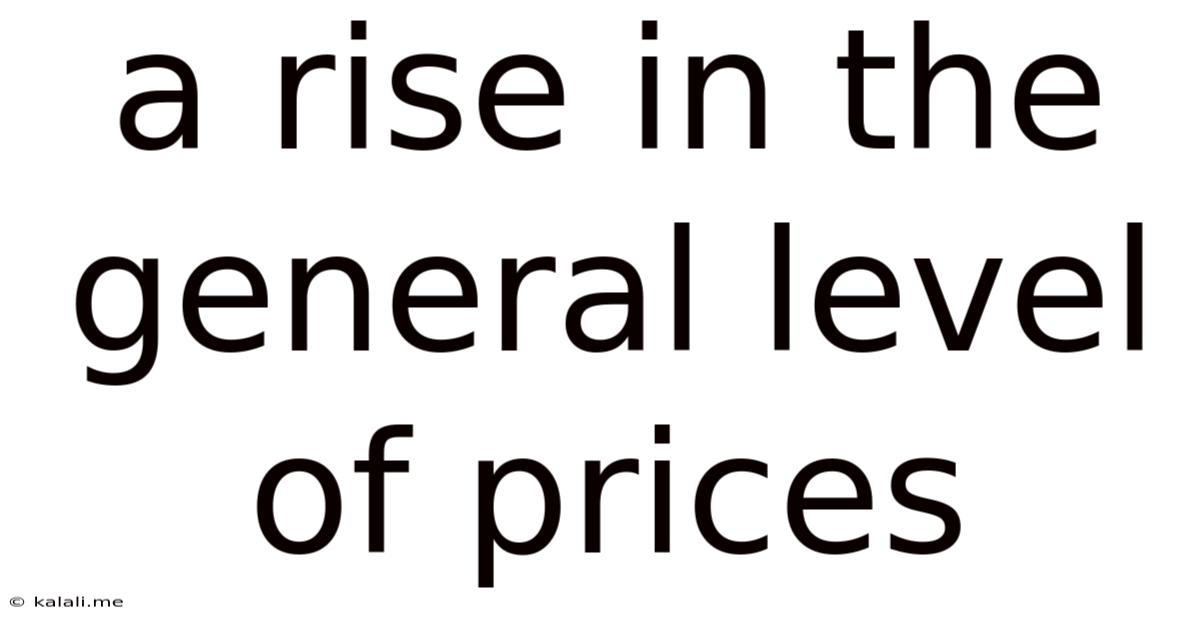A Rise In The General Level Of Prices
Kalali
Jun 13, 2025 · 3 min read

Table of Contents
A Rise in the General Level of Prices: Understanding Inflation
Inflation, a persistent rise in the general price level of goods and services in an economy over a period of time, is a complex economic phenomenon with far-reaching consequences. This article delves into the causes, effects, and measurement of inflation, offering a comprehensive understanding of this crucial economic indicator. Understanding inflation is crucial for individuals, businesses, and policymakers alike, as it impacts purchasing power, investment decisions, and overall economic stability.
What Causes Inflation?
Several factors contribute to inflation. A primary driver is demand-pull inflation, where aggregate demand outstrips the economy's capacity to produce goods and services. This increased demand, fueled by factors like increased consumer spending, government spending, or investment, pushes prices upwards. Think of it like a bidding war: more people wanting a limited supply of goods inevitably increases prices.
Another significant factor is cost-push inflation, where rising production costs – such as wages, raw materials, or energy – are passed on to consumers in the form of higher prices. Supply chain disruptions, increased energy prices, and rising labor costs are common contributors to this type of inflation.
Furthermore, built-in inflation can occur when expectations of future price increases lead to wage demands and price increases that become self-fulfilling prophecies. This is often referred to as a wage-price spiral, where rising wages lead to higher prices, which then justify further wage increases. Government policies, such as excessive money printing (monetary policy) or excessive government spending (fiscal policy), can also significantly influence inflation rates.
Measuring Inflation: Key Indicators
Economists use various indicators to measure inflation, the most common being the Consumer Price Index (CPI) and the Producer Price Index (PPI). The CPI tracks the average change in prices paid by urban consumers for a basket of consumer goods and services, providing a broad measure of consumer inflation. The PPI, on the other hand, measures the average change in prices received by domestic producers for their output. Tracking these indices allows economists and policymakers to monitor inflation trends and implement necessary adjustments. Other related measures include the GDP deflator, which measures the price level of all goods and services produced in an economy.
The Effects of Inflation
Inflation's impact extends throughout the economy. High inflation erodes purchasing power, meaning consumers can buy fewer goods and services with the same amount of money. This disproportionately affects individuals on fixed incomes, such as retirees, as their income doesn't keep pace with rising prices. Furthermore, high and unpredictable inflation creates uncertainty, making it difficult for businesses to plan for the future and invest in expansion. This uncertainty can hinder economic growth and lead to job losses. High inflation also leads to increased interest rates as central banks attempt to curb inflation by making borrowing more expensive.
Managing Inflation: Policy Responses
Governments and central banks employ various strategies to manage inflation. Monetary policy, controlled by central banks, involves adjusting interest rates and the money supply to influence inflation. Raising interest rates makes borrowing more expensive, reducing consumer spending and investment, thus cooling down inflationary pressures. Fiscal policy, managed by governments, involves adjusting government spending and taxation to influence aggregate demand. Reducing government spending or increasing taxes can help curb inflation by reducing overall demand.
Conclusion: Navigating the Inflationary Landscape
Inflation is a dynamic economic force with profound implications for individuals, businesses, and the overall economy. Understanding its causes, measurement, and effects is critical for making informed decisions and navigating the complexities of economic fluctuations. By monitoring key indicators, implementing effective policy responses, and adapting to changing economic conditions, societies can strive to maintain a stable and prosperous economic environment.
Latest Posts
Latest Posts
-
Write An Equation For These Two Complementary Angles
Jul 01, 2025
-
How Do You Beat Bloxorz Level 7
Jul 01, 2025
-
How Old Are You If Your Born In 1992
Jul 01, 2025
-
How Many Quarts Are In 15 Gallons
Jul 01, 2025
-
How Many Ounces Are In A Bag Of Flour
Jul 01, 2025
Related Post
Thank you for visiting our website which covers about A Rise In The General Level Of Prices . We hope the information provided has been useful to you. Feel free to contact us if you have any questions or need further assistance. See you next time and don't miss to bookmark.